地幔柱通常被认为是自核幔边界上升、在地幔中演化、到近地表与地壳发生壳幔相互作用的圆柱状地质体[1]。Morgan指出溢流玄武岩与大陆裂谷之间存在密切的联系,首次提出地幔柱活动和正常海底扩张之间存在联系[2]。Richards et al.识别出了约十个溢流玄武岩省,认为这是地幔柱头部的表现形式,并与大陆裂谷联系起来,并且指出岩石圈减薄并不是溢流玄武岩喷发的先决条件[3],这种观点可以归为“主动”裂谷模式[4-7]。主动裂谷模式具有以下几个地质过程,包括:岩石圈底部地幔柱头部的烘烤、热边界层的剥离、上覆地层的横向扩展和对流加热、地幔柱头部侵蚀岩石圈的小型对流以及上覆冷的岩石圈隆升和张性破坏[8]。东非裂谷作为一条正在裂开的大陆裂谷,一直受到了国际地质学家的广泛关注,对东非裂谷的研究成为研究板块运动及其地球动力学机制、岩浆演化和深部过程的理想场所。然而东非裂谷的打开是否与地幔柱有关,东非裂谷下是否存在地幔柱以及有多少个地幔柱一直存在争论[9-26]。本文从地球物理、岩石学及地球化学等证据出发,总结了近年来关于东非裂谷地幔柱的研究成果,指出在不均一的非洲超级地幔柱的基础上,分异出两个浅部地幔上升流的模型是东非裂谷地幔柱最有可能的存在形式。
1 东非裂谷地质背景
东非裂谷是世界上最典型的一条大陆裂谷,也是世界上已知最大的火成岩省之一,近南北向横切埃塞俄比亚高原和东非高原(图1)。它是一个更大的从红海和亚丁湾一直延伸到莫桑比克赞比西河的非洲-阿拉伯裂谷系的一部分[27,28]。非洲-阿拉伯裂谷系包含东非裂谷的东西两支、埃塞俄比亚裂谷、亚丁湾、红海和地中海东部裂谷。东非裂谷发育在大陆内部,形成于非洲古老的前寒武纪台地上,通常认为裂谷是由东部分支和西部分支两部分组成[29](图2)。东非裂谷的东支年龄较老且岩浆活动频繁,包括埃塞俄比亚南部、肯尼亚和坦桑尼亚北部;西部分支比东部分支年轻且岩浆活动比较少,包括一系列的深水湖泊,从北部的艾伯特湖(Lake Albert)向南经爱德华湖(Lake Édouard)、基伍湖(Lake Kivu)、坦噶尼喀湖(Lake Tanganyika)等到南部的马拉维湖(Lake Malawi),总长约2 100 km[30-32]。裂谷的东部分支具有显著的向北逐渐变老的特征,表现为在坦桑尼亚北部为裂谷的青年期、肯尼亚为成熟期、而在埃塞俄比亚以及阿法尔(Afar)则表现为大陆裂谷向最初的洋底扩张转变。西部分支的裂谷盆地依然具有裂谷初期的几何形态,整体上还没有演化到成熟裂谷期[29,33]。裂谷东西两分支在坦桑尼亚境内围绕坦桑尼亚克拉通分布[34-38](图1)。东非裂谷的岩浆岩地球化学特征具有很强的区域发展趋势,在阿法尔地区、埃塞俄比亚裂谷和肯尼亚裂谷主要是起源于岩石圈之下(软流圈加地幔柱)地幔扩散的拉斑玄武-过渡岩浆,肯尼亚裂谷同时还受到了岩石圈组分的影响[24-25,39-46]。相比之下,包括Toro Ankole、维龙加(Virunga)、基伍(Kivu)和伦圭(Rungwe)火山岩省的西部分支火山作用开始时间较晚(≤23 Ma),而且是零星分布且体积较小。
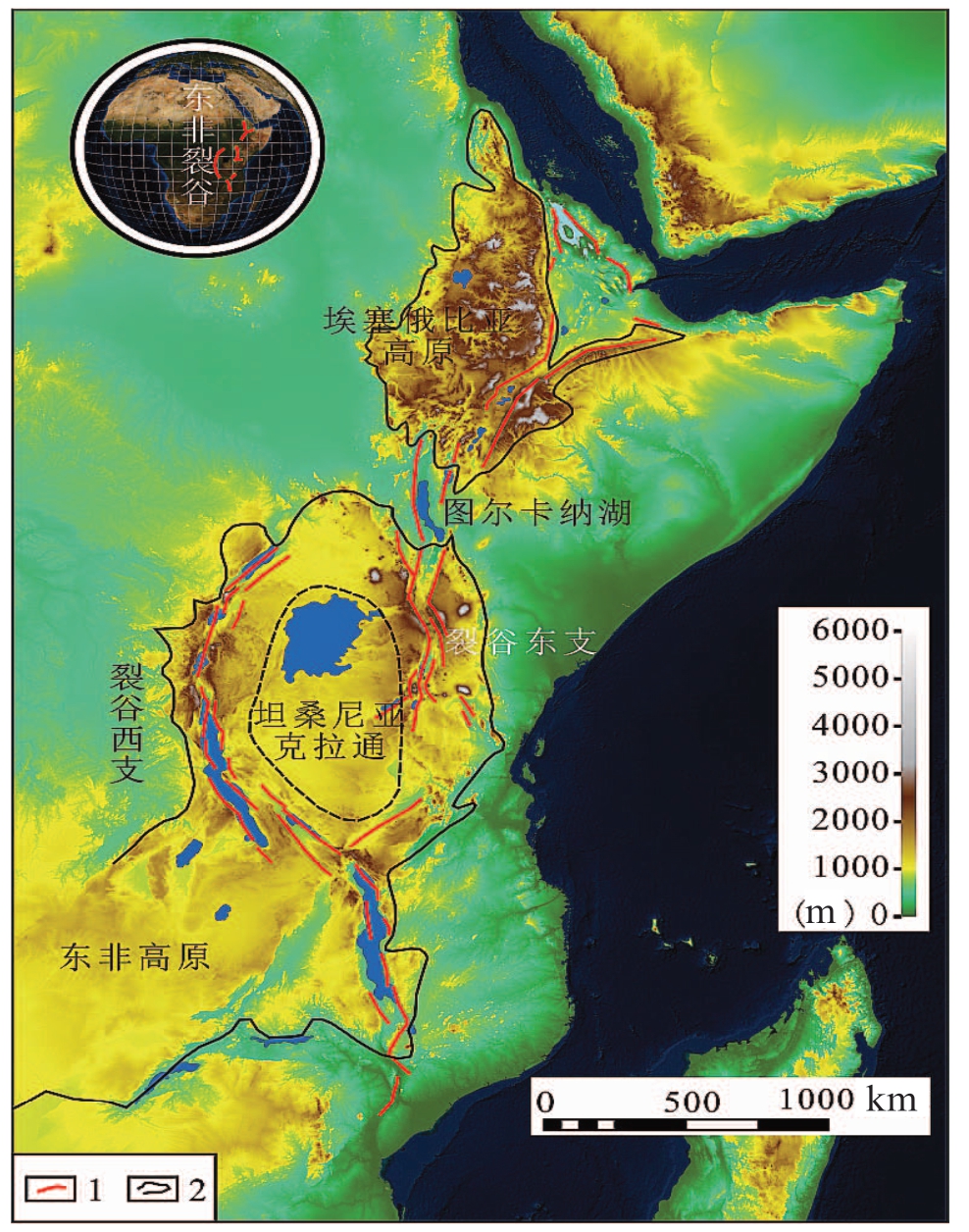
图1 东非裂谷数字高程图
Fig.1 Digital elevation map of East African Rift
1.裂谷断层;2.高原边界
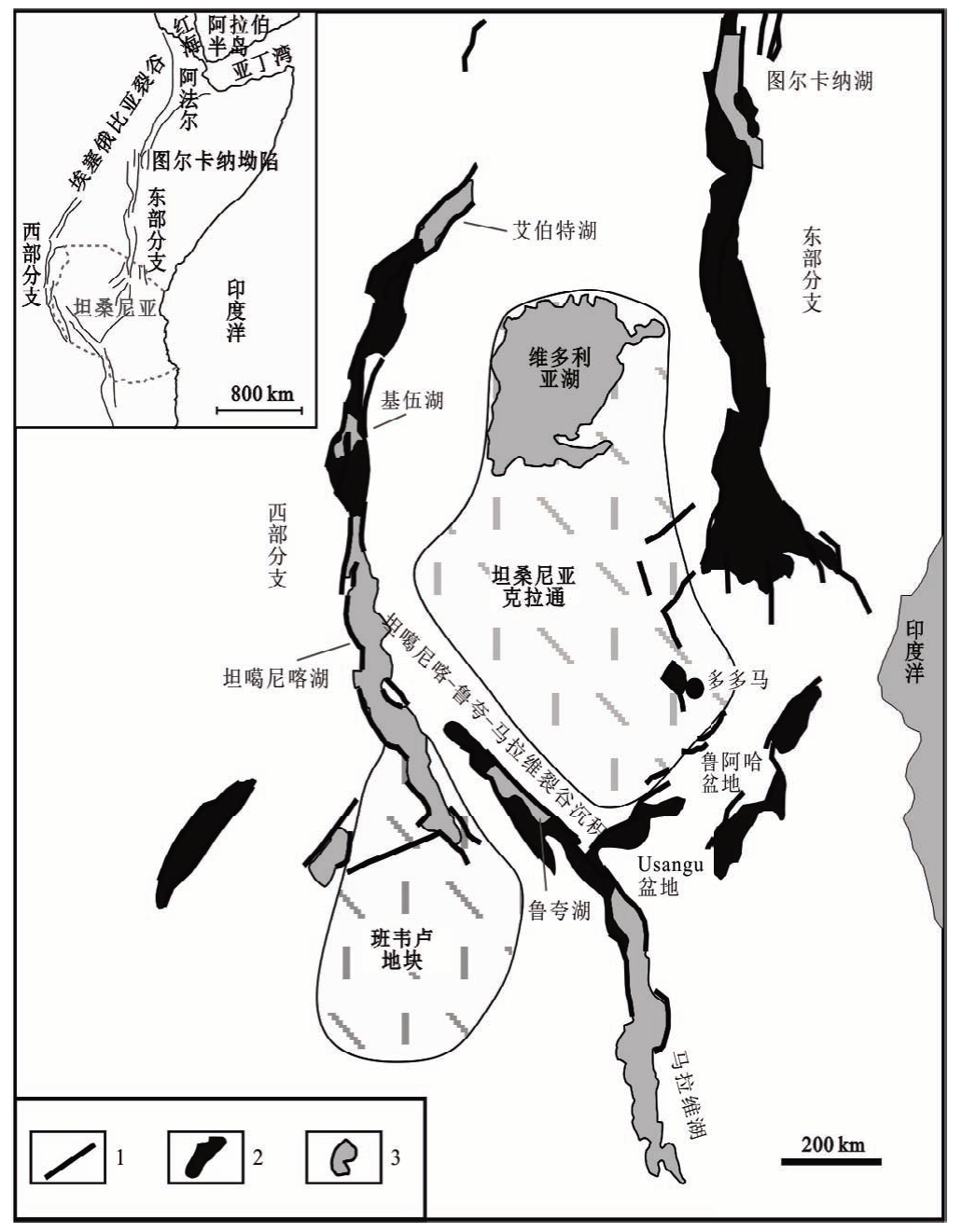
图2 东非裂谷南部地质构造简图(据参考文献[34,47])
Fig.2 Regional structure schematic map of the East African Rift
1.裂谷断层;2.晚新生代裂谷沉积和火山岩;3.湖泊和海洋
2 东非裂谷地幔柱存在的证据
东非裂谷的发展和演化历史,尤其是裂谷前的火山作用一直是前人研究的重点并且认为至少存在一个上升的地幔柱[3,27,48-55]。经典的热柱流体动力学实验认为地幔柱具有一个大的球形的地幔柱头部和一个细长的地幔柱尾[4,56]。这种几何形态与东非裂谷北部和一些热点区域的岩浆作用特征相符:地幔柱头部达到岩石圈的底部,大量的溢流玄武岩在短时间内就位并伴随着持续数十个百万年的少量地幔柱尾岩浆作用[2]。人们认为这种地幔柱形成于地幔内部的热边界层,可能位于地幔的底部[2-3,57]。
越来越多的地球物理证据表明,深部地幔的地球化学不均一性是俯冲板片穿过660 km地震波不连续面的累积作用的结果[58],使得这部分地幔在很长的时间内混合程度都比较低[59,60]。化学性质不均一性在非洲和南大西洋下的深部地幔地震异常区尤为显著,被称为非洲超级地幔柱[61,62]。这种大型下地幔区域与南太平洋具有相似的特征,并具有热的和高密度的热化学异常[63]。这些区域在地质历史上是相当稳定的[64],全球热点活动的历史表明局部的地幔柱上升可能来源于这些结构的边缘[65]。建模研究[66-69]表明,深部地幔热化学不均一性的形成(即古再循环洋壳板片)可以导致地幔上涌,并表现出与经典热地幔柱迥异的特征(如偶发性喷发、不合理的地幔柱头部和从大型地幔柱分异出来的小型次级地幔柱),在地表的表现主要为火山作用的性质和规模大小。
东非裂谷的形成与阿法尔地区(埃塞俄比亚)和维多利亚湖(坦桑尼亚)下部的地幔上涌有关,这已经得到了地球物理数据的证实[70-72]。与这些地幔上涌有关的早期火山作用分别出现在埃塞俄比亚西北-也门西南(约30 Ma)[52]和埃塞俄比亚南部-肯尼亚北部(45~40 Ma)[24,73]。具体来说,埃塞俄比亚西北约30 Ma溢流玄武岩在同位素和地球化学上与具有高3He/4He比值的OⅠB类似[74]。该地区后中新世至今火山活动的岩浆量少并仅局限在现代裂谷的轴部。相反,肯尼亚北部的中新世玄武岩和橄榄岩同位素比值具有HⅠMU 地幔成分,具有较低的3He/4He比值[23,24]。该区的火山作用偶发性更强,火山活动具有5~10 Ma的空白期。为了更好地了解东非裂谷初始裂开的过程,研究这些早期的、独特的火山事件的起源具有重要意义。
2.1 地球物理证据
地球物理数据表明在阿法尔地区和坦桑尼亚克拉通下440~660 km 深处存在地幔温度升高形成的低速异常区[16,22,71,72,75-80]。地震研究表明阿法尔下的低速区向西倾[72],可能在660 km 或者更深处与坦桑尼亚下的低速带合并在一起(图3)[81]。全球成像模型表明这个弱的结合异常继续向西倾,并且可能与具有大型、深部低速特征的非洲超级地幔柱或超级地幔上涌合并[13,81,82]。非洲超级地幔柱起源于南部非洲之下的核幔边界,并向东北延伸,在维多利亚湖地区接近岩石圈的底部[13,83]。
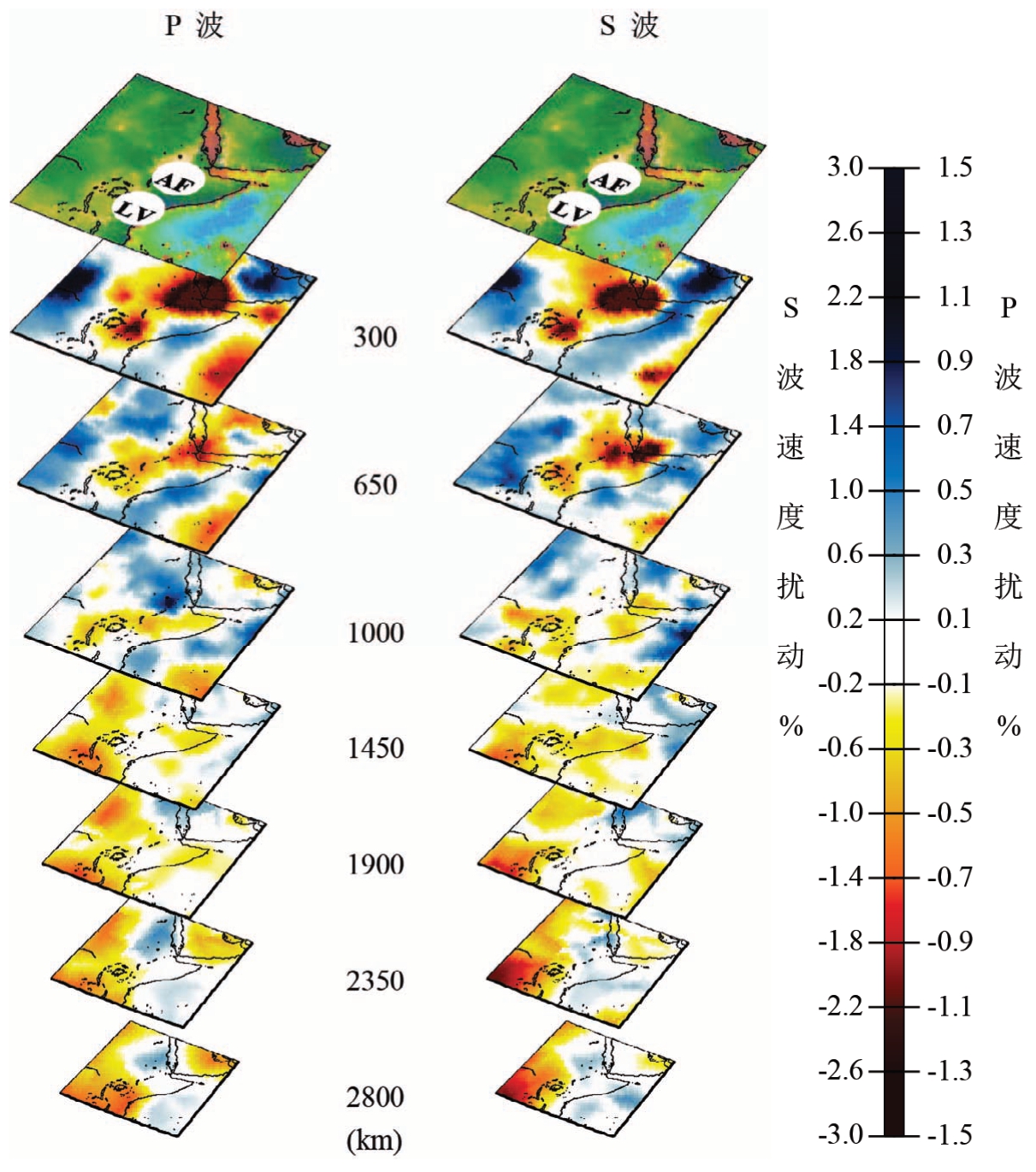
图3 东非地幔柱地震波层析成像三维视图(据参考文献[81])
Fig.3 Three-dimensional view of the plumes beneath the East Africa
AF:阿法尔;LV:维多利亚湖
由于地幔转换带下的尖晶石-钙钛矿相变形成了清晰的地震成像,导致该地区的上下地幔间的低速带并不明显。因此,目前还无法确定异常起源的极限深度[72,76,81]。但是研究表明浅部低速区和深部非洲超级地幔柱之间存在联系[16,80,84]。Huerta et al.报道了由于地幔温度升高导致钙钛矿-镁铝硅酸盐相变,在肯尼亚和坦桑尼亚北部裂谷之下440 km 深存在一个局部不连续凹陷面,以及660 km深不连续面中存在一个大型区域不连续凹陷[84]。Huerta et al.认为这些特征可能是源于非洲超级地幔柱异常高温、上升的地幔物质停留在转换带底部并形成一个横跨660 km深不连续面的热扰动[84]。他们认为,大范围的热流随后形成了小型局部热不稳定,上升到肯尼亚和西部分支裂谷下部。在深部地幔,Sun et al.利用波形成像技术来反演非洲超级地幔柱头部散发出来的窄管状结构的形状,表明形成这种结构确实是可行的[85]。虽然由于地震分辨率的局限性,目前还无法将这些浅部低速带明确地与非洲超级地幔柱联系起来,但上述结果支持存在这种联系的观点。
2.2 岩石学及地球化学证据
大陆裂解主要阶段之前的早期裂谷中通常发育双峰式火山作用和一些大火成岩省[86,87],东非裂谷火山岩就表现出典型的双峰式火山岩特征[88],而双峰式火山作用可以提供地幔的化学和物理性质的关键信息,这对于理解大陆裂谷的驱动力具有重要意义[89],也是了解触发地幔柱和最终大陆裂解原因的重要窗口[90]。
东非裂谷双峰式火山岩的基性岩主要是富碱质的,成分上从拉斑玄武岩至碱性玄武岩再到硅不饱和的碧玄岩、霞石岩和超钾质的白榴岩以及碳酸岩等,中酸性岩也是偏碱质的,如粗面岩、响岩和碱性流纹岩等[91]。基性岩中的拉斑玄武岩通常富LⅠLE、Th 和HFSE,Zr/Nb 比值低(310),LREE/HREE 为明显分离的型式,LREE丰度较高,其中La为球粒陨石的50~500 倍;碱性玄武岩明显富集稀土元素,87Sr/86Sr 比值具有较大的变化范围(0.703~0.710)[92]。酸性岩明显富集LREE 和HFSE,Th 含量较高。地球化学研究表明,东非裂谷的基性和酸性火山岩的Yb、Y 两元素随SiO2含量的增加呈正相关关系,表明东非裂谷火山岩与板块俯冲无关[93]。Sr随SiO2含量的增加表现出两个不连续的分异趋势,并且分布在地幔源区和地壳分异结晶区两个不同的范围。TiO2随SiO2含量的增加呈递减趋势,表明酸性火山岩来源于深部玄武质岩浆分异并混染各种陆源成分[93]。东非裂谷的基性火山岩普遍具有高Nb 和Ta含量的特征,而且比较集中在地幔热柱区域的范围内,显示其地幔柱成因[93]。
埃塞俄比亚裂谷最南端图尔卡纳前-裂谷型玄武岩的Ce/Pb 比值>30~50,La/Nb 比值≤1,具有无混染岩石圈上地幔的特征,而埃塞俄比亚西北和阿法尔的渐新-中新世玄武岩的Ce/Pb比值=10~30,表明受到了地壳不同程度的混染,显示其地幔源区与峨眉山玄武岩相似,均来自深部地幔柱[93]。
同位素方面,前人的研究表明在埃塞俄比亚中部和北部的基性岩浆同位素特征与埃塞俄比亚南部和肯尼亚完全不同[24,41,53,54,94,95]。埃塞俄比亚西北最初的溢流玄武岩具有放射成因的87Sr/86Sr 比值约为0.704,143Nd/144Nd 比值约为0.512 95,206Pb/204Pb 比值约为18.8~19.2的特征(图4)[53]。这种物质最初被认为是HⅠMU型[96],但Rooney et al.(2012)认为这是“普通”地幔组分[25],代表了具有年轻(<1Ga)再循环富水大洋岩石圈组分的地幔[97,98]。总体上,埃塞俄比亚北部地区的所有岩浆与那些来自亏损MORB地幔的岩浆(R/Ra=8±1)[99]相比具有高3He/4He比值(R/Ra=9~19)[23,25,74](图4)。高3He/4He比值表明这些岩浆来自于具有高度富集原始3He的地幔,但3He是驻留在一个完全脱气的地幔[100-103]还是熔融地幔[104,105]仍存在争论。
相反,相对于埃塞俄比亚溢流玄武岩,图尔卡纳(肯尼亚北部)早期(40~32 Ma和26~16 Ma)基性火山岩具有较低的放射性成因87Sr/86Sr(0.7030),放射性成因206Pb/204Pb 比值较高(达到20.4)以及较低的3He/4He比值(R/Ra=6~8)[23,24,43,107,108](图4)。这些高206Pb/204Pb、低87Sr/86Sr和低3He/4He值与HⅠMU地幔组分类似[109,110]。图尔卡纳和附近的Huri山的上新世和第四纪基性岩浆形成于大陆裂谷之后已经得到了大家的认可,与该地区老的火山作用相比,这些年轻的岩浆具有较低的206Pb/204Pb 比值[111,112],接近埃塞俄比亚北部的Pb 同位素比值。但是,肯尼亚岩浆的3He/4He 从未超过7 Ra[24,113],与北部的岩浆相比放射性成因87Sr/86Sr值(0.703 0~0.703 2)普遍较低。
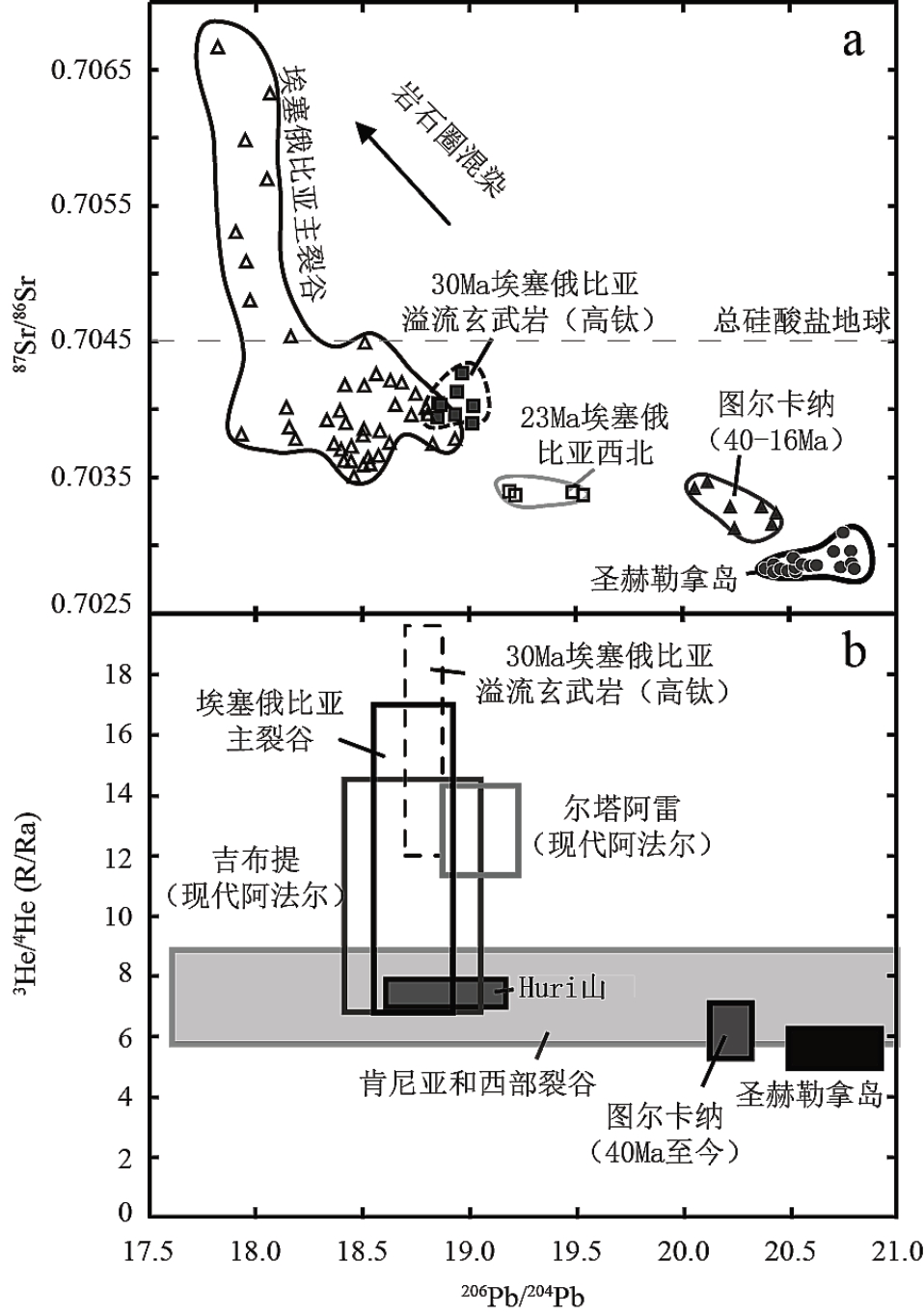
图4 埃塞俄比亚西北和图尔卡纳(肯尼亚北部)初始火山产物的同位素对比图(据参考文献[106])
Fig.4 Isotopic comparison of initial volcanic produces in NW Ethiopia and Turkana (NW of Kenya)
a.埃塞俄比亚和肯尼亚北部基性岩浆206Pb/204Pb和87Sr/86Sr图;b.东非裂谷基性岩浆3He/4He和206Pb/204Pb图
西部裂谷的基伍和伦圭岩浆要比裂谷前埃塞俄比亚西北溢流玄武岩和图尔卡纳岩浆要年轻得多(<10 Ma)。同位素方面,基伍地区的基性岩浆具有87Sr/86Sr=0.703 1~0.705 2 和143Nd/144Nd=0.513 03~0.512 66的特征,与埃塞俄比亚西北或图尔卡纳的岩浆相比具有更多的放射性成因比值[43]。伦圭熔岩的87Sr/86Sr=0.704 5~0.705 7、143Nd/144Nd=0.512 4~0.512 6、206Pb/204Pb=17.65~18.90[114],3H/4He从MORB型(7~9 RA)[114]到地幔柱型(9~15 RA)[115]。主量元素和微量元素数据表明基伍和伦圭熔体的形成与交代陆下岩石圈地幔有关[43,107,114,116]。
Nelson et al.(2012)报道了埃塞俄比亚西北的溢流玄武岩(约30 Ma)的187Os/188Os=0.123 9~0.131 1、176Hf/177Hf=0.283 11~0.283 15,与“普通”地幔成分一致[106]。相反,图尔卡纳橄榄岩(23~16 Ma)的放射性成因187Os/188Os 比值(0.145 0~0.148 3)表明具有HⅠMU 组分的贡献,而这在埃塞俄比亚西北并不存在。这两种组分的混合模型表明HⅠMU组分可能是1.7 Ga的富水洋壳与“普通”地幔物质混合的结果。
3 东非裂谷的地幔动力学模型
支持东非裂谷下存在一个或者多个地幔柱的最有力证据可能是裂谷前火山作用源区缺乏浅部、亏损MORB 地幔的贡献[3,48,50,54,55,117]。如果这一系列的火山作用不是地幔柱成因的,那么被动裂谷成因需要裂谷前的岩浆具有浅部地幔的地球化学特征。但前人的研究并不能证明这个假设,来自埃塞俄比亚西北部和图尔卡纳的橄榄岩表明,阿法尔和肯尼亚地幔柱火山产物具有不同地幔源区组分的同位素特征。如果普通地幔源区存在古老再循环洋壳的话,也能够在两个地区形成同位素组成截然不同的火山产物,这一假设也得到了187Os/188Os数据的支持[106]。
单纯依靠地球化学数据并不能解决上升地幔柱携带再循环物质的深度问题(是在靠接核幔边界、靠近660 km不连续面、还是俯冲物质熔融到大陆岩石圈基底?)。地球物理数据表明南部非洲深部密度变化和热扰动地幔是由于热和地球化学不均一性引起的[61,62]。那么,地幔柱成因岩浆作用所表现的地球化学性质的变化表明,非洲超级地幔柱是具有不同化学成分的地幔物质。流体动力学模型表明洋壳可能在核幔边界混入受热上升物质中。更特别的是,这些模型表明经典热地幔柱的行为(地幔柱头部喷发大量溢流玄武岩,随后地幔柱尾喷发少量岩浆)受组分变化的影响比较大(如混入洋壳物质)。相对于热地幔柱,具有不均一组分的地幔柱通常发源于广泛的、不连续的或间断结构的热化学障层[66,67,118,119],但这种热化学障又会抑制地幔柱头部的形成。这种形式的上涌将会导致火山喷发量的减少,并且可能会抑制溢流玄武岩省的形成[118]。热化学上升流也可能会停留在中地幔,只剥落少部分地幔柱上升到地表[67,118,120]。
从地球化学不均一的非洲超级地幔柱分异出来的次级地幔柱能够形成阿法尔和肯尼亚截然不同的喷发行为和地球化学性质[106]。将东非裂谷地球化学和地球物理数据应用到基于非洲下地幔热化学性质和上升地幔柱热化学反应的动态结果建立的动态模型上,能够很好地解释阿法尔和肯尼亚地幔柱的不同地球化学性质。假设再循环洋壳的引入导致下地幔出现化学不均一性[121,122]。这种高密度物质进入到上升地幔柱能够与橄榄岩地幔物质混合,形成图尔卡纳地区基性岩浆的Sr\Nd\Pb\Hf\Os 同位素特征。假设高压相的再循环洋壳具有比周围地幔更高的密度。下地幔上部比洋壳密度高的地幔[123]对该模型的影响非常有限。地球动力学研究表明除极端流变变化的情况下[124],这种密度差并不能阻止俯冲板片进入下地幔[125]。这种密度差对弥散型的上升流影响较大[126,127],但对于集中的地幔柱型上升流则基本没有影响[67]。再循环洋壳和橄榄岩之间的热化学作用导致肯尼亚地幔柱到达地表后并没有形成溢流玄武岩。由于再循环洋壳在化学和同位素方面与深部地幔显著不同,这可能就是地震成像所显示的非洲超级地幔柱化学致密物[61,62]。相反,阿法尔地幔柱并没有支持再循环洋壳混入的同位素或喷发特征的证据,而是一个典型的热柱的特征。因此,这种地幔柱形成了具有高3He/4He比值、“普通”地幔熔融成分地球化学特征的大量溢流玄武岩。
地球物理数据表明阿法尔和肯尼亚地幔柱可能存在深部的联系。Nelson et al.(2012)提出了在不均一的非洲超级地幔柱上分异出来的两个浅部地幔上升流的模型[106](图5)。动力学建模证实从大型不均一地幔上升流中分异的次级地幔柱能够形成区域上地球化学和喷发特征上的差异[66]。在这种情况下,阿法尔地幔柱的喷发特征和同位素组分表明地幔柱可能起源于缺乏致密物质的超级地幔柱区域。阿法尔地幔柱可能位于致密物质之上,为一个热柱[68,128]。
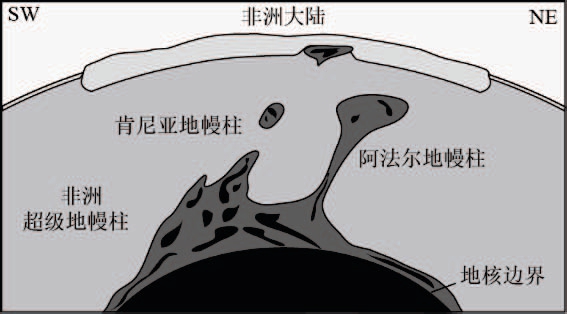
图5 裂谷前非洲地幔柱模型(据参考文献[106])
Fig.5 Schematic model of the mantle below Africa before rifting
相比之下,肯尼亚下部的上升流可能来源于具有高密度区域的超级地幔柱(即大量的俯冲洋壳),这种高密度物质的重力略小于地幔柱的热浮力。这种情况允许将再循环物质混入到地幔柱中,从而破坏了典型地幔柱的发展和喷发属性。
4 结论
来自埃塞俄比亚西北部和图尔卡纳地区的裂谷前玄武岩和橄榄岩地球化学数据表明其源自与地幔柱岩浆作用有关的火山喷发。这两个地区具有不同地球化学性质的岩浆岩,表明埃塞俄比亚溢流玄武岩具有“普通”地幔的成分而图尔卡纳橄榄岩则为“普通”地幔与古老再循环洋壳混合的结果,分别与阿法尔和肯尼亚地幔柱有关。两个地幔柱所表现出来的不同地球化学性质与非洲超级地幔柱的热化学不均一性有关。这种地幔柱性质的差异造成了肯尼亚和阿法尔地幔柱地球化学和喷发形式的不同。
[1]王登红.地幔柱的概念,分类,演化与大规模成矿—对中国西南部的探讨[J].地学前缘,2001,8(3):67-72.
[2]MORGAN W J.Convection plumes in the lower mantle[J].Nature,1971,230(5288):42-43.
[3]RICHARDS M A,DUNCAN R A,COURTILLOT V E.Flood basalts and hot-spot tracks: plume heads and tails[J].Science,1989,246(4926):103-107.
[4]CAMPBELL I H,GRIFFITHS R W.Implications of mantle plume structure for the evolution of flood basalts[J].Earth and Planetary Science Letters,1990,99(1-2):79-93.
[5]HOOPER P R.The timing of crustal extension and the eruption of continental flood basalts[J].Nature,1990,345(6272):246.
[6]HILL R I.Starting plumes and continental break-up[J].Earth and Planetary Science Letters,1991,104(2-4): 398-416.
[7]GRIFFITHS R W,CAMPBELL I H.Interaction of mantle plume heads with the Earth's surface and onset of smallscale convection[J].Journal of Geophysical Research: Solid Earth,1991,96(B11):18295-18310.
[8]COURTILLOT V,JAUPART C,MANIGHETTI I,et al.On causal links between flood basalts and continental breakup[J].Earth and Planetary Science Letters,1999,166(3-4):177-195.
[9]KONTER J G,HANAN B B,BLICHERT-TOFT J,et al.One hundred million years of mantle geochemical history suggest the retiring of mantle plumes is premature[J].Earth and Planetary Science Letters,2008,275(3-4):285-295.
[10]ANDERSON D L.Hawaii,boundary layers and ambient mantle—geophysical constraints[J].Journal of Petrology,2011,52(7-8):1547-1577.
[11]CASTILLO P R,HILTON D R,HALLDÓRSSON S A.Trace element and Sr-Nd-Pb isotope geochemistry of Rungwe Volcanic Province,Tanzania: implications for a Superplume source for East Africa Rift magmatism[J].Frontiers in Earth Science,2014,2:21.
[12]EBINGER C J,SLEEP N H.Cenozoic magmatism throughout east Africa resulting from impact of a single plume[J].Nature,1998,395(6704):788.
[13]RITSEMA J,VAN HEIJST H J,WOODHOUSE J H.Complex shear wave velocity structure imaged beneath Africa and Iceland[J].Science,1999,286(5446):1925-1928.
[14]DARADICH A,MITROVICA J X,PYSKLYWEC R N,et al.Mantle flow,dynamic topography,and rift-flank uplift of Arabia[J].Geology,2003,31(10):901-904.
[15]NYBLADE A A.The upper-mantle low-velocity anomaly beneath Ethiopia,Kenya,and Tanzania: Constraints on the origin of the African superswell in eastern Africa and plate versus plume models of mantle dynamics[J].Geological Society of America Special Papers,2011,478:37-50.
[16]HANSEN S E,NYBLADE A A,BENOIT M H.Mantle structure beneath Africa and Arabia from adaptively parameterized P-wave tomography: Implications for the origin of Cenozoic Afro-Arabian tectonism[J].Earth and Planetary Science Letters,2012,319:23-34.
[17]GRIJALVA A N,KACHINGWE M,NYBLADE A,et al.Upper mantle P-wave velocity structure beneath northern Lake Malawi and the Rungwe Volcanic Province,East Africa[C].2015.
[18]ACCARDO N J,GAHERTY J B,SHILLINGTON D J,et al.Surface wave imaging of the weakly extended Malawi Rift from ambient-noise and teleseismic Rayleigh waves from onshore and lake-bottom seismometers[J].Geophysical Journal International,2017,209(3):1892-1905.
[19]KACHINGWE M,NYBLADE A,EBINGER C J,et al.Preliminary results on crust and upper mantle structure in the Rungwe Volcanic Province,Tanzania from the SEGMeNT project[R].Thin Soild Films,2014.
[20]MASON R.Basement Tectonics 7[M].Springer Science &Business Media,1992.
[21]TEPP G,EBINGER C J,SHILLINGTON D J,et al.Seismic Anisotropy of the Upper Mantle Below the Southwestern East African Rift and the Rungwe Volcanic Province[C].2016.
[22]CHANG S,VAN DER LEE S.Mantle plumes and associated flow beneath Arabia and East Africa[J].Earth and Planetary Science Letters,2011,302(3-4):448-454.
[23]PIK R,MARTY B,HILTON D R.How many mantle plumes in Africa?The geochemical point of view[J].Chemical Geology,2006,226(3-4):100-114.
[24]FURMAN T,KALETA K M,BRYCE J G,et al.Tertiary mafic lavas of Turkana,Kenya: constraints on East African plume structure and the occurrence of high-μ volcanism in Africa[J].Journal of Petrology,2006,47(6):1221-1244.
[25]ROONEY T O,HANAN B B,GRAHAM D W,et al.Upper mantle pollution during Afar plume-continental rift interaction[J].Journal of Petrology,2011,53(2):365-389.
[26]ARMITAGE J J,FERGUSON D J,GOES S,et al.Upper mantle temperature and the onset of extension and breakup in Afar,Africa[J].Earth and Planetary Science Letters,2015,418:78-90.
[27]BAKER B T,WOHLENBERG J.Structure and evolution of the Kenya Rift Valley[J].Nature,1971,229(5286):538.
[28]MCCONNELL R B.Geological development of the rift system of eastern Africa[J].Geological Society of America Bulletin,1972,83(9):2549-2572.
[29]RING U.THE EAST AFRICAN RIFT SYSTEM.[J].Austrian Journal of Earth Sciences,2014,107(1):132-146.
[30]郭曦泽,侯贵廷.东非裂谷系西支(湖区)油气资源潜力评价与分析[J].地球科学前沿,2004,4(2):94-103.
[31]JAKOVLEV A,RÜMPKER G,SCHMELING H,et al.Seismic images of magmatic rifting beneath the western branch of the East African rift[J].Geochemistry,Geophysics,Geosystems,2013,14(11):4906-4920.
[32]BEGG G C,GRIFFIN W L,NATAPOV L M,et al.The lithospheric architecture of Africa: Seismic tomography,mantle petrology,and tectonic evolution[J].Geosphere,2009,5(1):23-50.
[33]KAMPUNZU A B,MOHR P.Magmatic evolution and petrogenesis in the East African rift system[M].Magmatism in extensional structural settings,Springer,1991,85-136.
[34]FONTIJN K,ERNST G G,ELBURG M A,et al.Holocene explosive eruptions in the Rungwe Volcanic Province,Tanzania[J].Journal of volcanology and geothermal research,2010,196(1-2):91-110.
[35]SUN K,ZHANG L,ZHAO Z,et al.Episodic crustal growth in the Tanzania Craton: evidence from Nd isotope compositions[J].China Geology,2018,1(2):210-224.
[36]YUAN Y,LI S,PENG J,et al.An integrated ore prospecting model for the Nyasirori gold deposit in Tanzania[J].China Geology,2019,2(4):407-421.
[37]任军平,王杰,刘晓阳,等.坦桑尼亚Nzega 绿岩带Golden Pride 金矿床研究进展[J].地质调查与研究,2013,36(1):47-53.
[38]何胜飞,孙凯,王杰,等.坦桑尼亚西北部卡邦加铜镍硫化物矿床研究进展[J].地质调查与研究,2014,37(1):6-12.
[39]ROGERS N W,DE MULDER M,HAWKESWORTH C J.An enriched mantle source for potassic basanites: evidence from Karisimbi volcano,Virunga volcanic province,Rwanda[J].Contributions to Mineralogy and Petrology,1992,111(4):543-556.
[40]ROGERS N W,JAMES D,KELLEY S P,et al.The generation of potassic lavas from the eastern Virunga province,Rwanda[J].Journal of Petrology,1998,39(6):1223-1247.
[41]ROGERS N,MACDONALD R,FITTON J G,et al.Two mantle plumes beneath the East African rift system: Sr,Nd and Pb isotope evidence from Kenya Rift basalts[J].Earth and Planetary Science Letters,2000,176(3-4):387-400.
[42]ROGERS N W,THOMAS L E,MACDONALD R,et al.238U-230Th disequilibrium in recent basalts and dynamic melting beneath the Kenya rift[J].Chemical Geology,2006,234(1-2):148-168.
[43]FURMAN T,GRAHAM D.Erosion of lithospheric mantle beneath the East African Rift system: geochemical evidence from the Kivu volcanic province[M].Developments in Geotectonics,Elsevier,1999:24,237-262.
[44]FURMAN T.Geochemistry of East African Rift basalts: an overview[J].Journal of African Earth Sciences,2007,48(2-3):147-160.
[45]CHAKRABARTI R,BASU A R,SANTO A P,et al.Isotopic and geochemical evidence for a heterogeneous mantle plume origin of the Virunga volcanics,Western rift,East African Rift system[J].Chemical Geology,2009,259(3-4):273-289.
[46]ROSENTHAL A,FOLEY S F,PEARSON D G,et al.Petrogenesis of strongly alkaline primitive volcanic rocks at the propagating tip of the western branch of the East African Rift[J].Earth and Planetary Science Letters,2009,284(1-2):236-248.
[47]DE MOOR J M,FISCHER T P,SHARP Z D,et al.Gas chemistry and nitrogen isotope compositions of cold mantle gases from Rungwe Volcanic Province,southern Tanzania[J].Chemical Geology,2013,339:30-42.
[48]SCHILLING J G.Afar mantle plume:rare earth evidence[J].Nature Physical Science,1973,242(114):2-5.
[49]WHITE R,MCKENZIE D.Magmatism at rift zones: the generation of volcanic continental margins and flood basalts[J].Journal of Geophysical Research: Solid Earth,1989,94(B6):7685-7729.
[50]VIDAL P,DENIEL C,VELLUTINI P J,et al.Changes of mantle sources in the course of a rift evolution:the Afar case[J].Geophysical Research Letters,1991,18(10): 1913-1916.
[51]STEWART K,ROGERS N.Mantle plume and lithosphere contributions to basalts from southern Ethiopia[J].Earth and Planetary Science Letters,1996,139(1-2):195-211.
[52]HOFMANN C,COURTILLOT V,FERAUD G,et al.Timing of the Ethiopian flood basalt event and implications for plume birth and global change[J].Nature,1997,389(6653):838.
[53]PIK R,DENIEL C,COULON C,et al.Isotopic and trace element signatures of Ethiopian flood basalts: evidence for plume-lithosphere interactions[J].Geochimica et Cosmochimica Acta,1999,63(15):2263-2279.
[54]KIEFFER B,ARNDT N,LAPIERRE H,et al.Flood and shield basalts from Ethiopia: magmas from the African superswell[J].Journal of Petrology,2004,45(4):793-834.
[55]FURMAN T,BRYCE J,ROONEY T,et al.Heads and tails:30 million years of the Afar plume[J].Geological Society,London,Special Publications,2006,259(1):95-119.
[56]WHITEHEAD JR J A,LUTHER D S.Dynamics of laboratory diapir and plume models[J].Journal of Geophysical Research,1975,80(5):705-717.
[57]VAN KEKEN P.Evolution of starting mantle plumes: a comparison between numerical and laboratory models[J].Earth and Planetary Science Letters,1997,148(1-2): 1-11.
[58]VAN DER HILST R D,WIDIYANTORO S,ENGDAHL E R.Evidence for deep mantle circulation from global tomography[J].Nature,1997,386(6625):578.
[59]KENNETT B,WIDIYANTORO S,VAN DER HILST R D.Joint seismic tomography for bulk sound and shear wave speed in the Earth's mantle[J].Journal of Geophysical Research:Solid Earth,1998,103(B6):12469-12493.
[60]LAY T,WILLIAMS Q,GARNERO E J.The core-mantle boundary layer and deep Earth dynamics[J].Nature,1998,392(6675):461.
[61]NI S,TAN E,GURNIS M,et al.Sharp sides to the African superplume[J].science,2002,296(5574):1850-1852.
[62]SIMMONS N A,FORTE A M,GRAND S P.Thermochemical structure and dynamics of the African superplume[J].Geophysical Research Letters,2007,34(2):2301.
[63]GARNERO E J,LAY T,MCNAMARA A.Implications of lower-mantle structural heterogeneity for the existence and nature of whole-mantle plumes[J].Special Papers-Geological Society of America,2007,430:79.
[64]BURKE K,STEINBERGER B,TORSVIK T H,et al.Plume generation zones at the margins of large low shear velocity provinces on the core-mantle boundary[J].Earth and Planetary Science Letters,2008,265(1-2):49-60.
[65]TORSVIK T H,BURKE K,STEINBERGER B,et al.Diamonds sampled by plumes from the core-mantle boundary[J].Nature,2010,466(7304):352.
[66]DAVAILLE A,LE BARS M,CARBONNE C.Thermal convection in a heterogeneous mantle[J].Comptes Rendus Geoscience,2003,335(1):141-156.
[67]LIN S,VAN KEKEN P E.Multiple volcanic episodes of flood basalts caused by thermochemical mantle plumes[J].Nature,2005,436(7048):250.
[68]LIN S,VAN KEKEN P E.Dynamics of thermochemical plumes:1.Plume formation and entrainment of a dense layer[J].Geochemistry,Geophysics,Geosystems,2006,7(2).
[69]KUMAGAI I,DAVAILLE A,KURITA K,et al.Mantle plumes: thin,fat,successful,or failing? Constraints to explain hot spot volcanism through time and space[J].Geophysical Research Letters,2008,35(16):797-801.
[70]EBINGER C J,BECHTEL T D,FORSYTH D W,et al.Effective elastic plate thickness beneath the East African and Afar plateaus and dynamic compensation of the uplifts[J].Journal of Geophysical Research: Solid Earth,1989,94(B3):2883-2901.
[71]SIMIYU S M,KELLER G R.An integrated analysis of lithospheric structure across the East African plateau based on gravity anomalies and recent seismic studies[J].Tectonophysics,1997,278(1-4):291-313.
[72]BENOIT M H,NYBLADE A A,VANDECAR J C.Upper mantle P-wave speed variations beneath Ethiopia and the origin of the Afar hotspot[J].Geology,2006,34(5):329-332.
[73]GEORGE R,ROGERS N,KELLEY S.Earliest magmatism in Ethiopia: Evidence for two mantle plumes in one flood basalt province[J].Geology,1998,26(10):923-926.
[74]MARTY B,GEZAHEGN Y.Helium isotopic variations in Ethiopian plume lavas:nature of magmatic sources and limit on lower mantle contribution[J].Earth and Planetary Science Letters,1996,144(1-2):223-237.
[75]ZEYEN H,VOLKER F,WEHRLE V,et al.Styles of continental rifting: crust-mantle detachment and mantle plumes[J].Tectonophysics,1997,278(1-4):329-352.
[76]NYBLADE A A,KNOX R P,GURROLA H.Mantle transition zone thickness beneath Afar: implications for the origin of the Afar hotspot[J].Geophysical Journal International,2000,142(2):615-619.
[77]NYBLADE A A,OWENS T J,GURROLA H,et al.Seismic evidence for a deep upper mantle thermal anomaly beneath east Africa[J].Geology,2000,28(7):599-602.
[78]WEERARATNE D S,FORSYTH D W,FISCHER K M,et al.Evidence for an upper mantle plume beneath the Tanzanian craton from Rayleigh wave tomography[J].Journal of Geophysical Research:Solid Earth,2003,108(B9).
[79]BASTOW I D,NYBLADE A A,STUART G W,et al.Upper mantle seismic structure beneath the Ethiopian hot spot:Rifting at the edge of the African low-velocity anomaly[J].Geochemistry,Geophysics,Geosystems,2008,9(12).
[80]ADAMS A,NYBLADE A,WEERARATNE D.Upper mantle shear wave velocity structure beneath the East African plateau: evidence for a deep,plateauwide low velocity anomaly[J].Geophysical Journal International,2012,189(1):123-142.
[81]MONTELLI R,NOLET G,DAHLEN F A,et al.A catalogue of deep mantle plumes: New results from finite-frequency tomography[J].Geochemistry,Geophysics,Geosystems,2006,7(11).
[82]GRAND S P.Mantle shear-wave tomography and the fate of subducted slabs[J].Philosophical Transactions of the Royal Society of London.Series A: Mathematical,Physical and Engineering Sciences,2002,360(1800):2475-2491.
[83]ZHAO D.Global tomographic images of mantle plumes and subducting slabs:insight into deep Earth dynamics[J].Physics of the Earth and Planetary Interiors,2004,146(1-2):3-34.
[84]HUERTA A D,NYBLADE A A,REUSCH A M.Mantle transition zone structure beneath Kenya and Tanzania: more evidence for a deep-seated thermal upwelling in the mantle[J].Geophysical Journal International,2009,177(3):1249-1255.
[85]SUN D,HELMBERGER D,GURNIS M.A narrow,midmantle plume below southern Africa[J].Geophysical Research Letters,2010,37(9):384-397.
[86]FRIZON DE LAMOTTE D,FOURDAN B,LELEU S,et al.Style of rifting and the stages of Pangea breakup[J].Tectonics,2015,34(5):1009-1029.
[87]LI W X,LI X H,LI Z.Ca.850 Ma bimodal volcanic rocks in northeastern Jiangxi Province,South China:Initial extension during the breakup of Rodinia?[J].American Journal of Science,2010,310(9):951-980.
[88]RASCHKA H,MULLER P.Contribution to the Geochemistry of Volcanics,Afar region,Ethiopia[J].Afar Depression of Ethiopia Stuttgart(Schuleizerbart),1975.
[89]WANG X,WILDE S A,XU B,et al.Origin of arc-like continental basalts: implications for deep-Earth fluid cycling and tectonic discrimination[J].Lithos,2016,261:5-45.
[90]LYU P,LI W,WANG X,et al.Initial breakup of supercontinent Rodinia as recorded by ca 860~840 Ma bimodal volcanism along the southeastern margin of the Yangtze Block,South China[J].Precambrian Research,2017,296:148-167.
[91]WILSON B M.Igneous petrogenesis a global tectonic approach[M].Springer Science&Business Media,2007.
[92]BAKER B H.Outline of the petrology of the Kenya rift alkaline province[J].Geological Society,London,Special Publications,1987,30(1):293-311.
[93]姚华舟,陈开旭,王建雄,等.东非裂谷系统(EARS)地幔柱成因的新生代火山作用地球化学标志[J].华南地质与矿产,2018,34(01):10-21.
[94]PIK R,DENIEL C,COULON C,et al.The northwestern Ethiopian Plateau flood basalts: classification and spatial distribution of magma types[J].Journal of Volcanology and Geothermal Research,1998,81(1-2):91-111.
[95]GEORGE R,ROGERS N.Plume dynamics beneath the African plate inferred from the geochemistry of the Tertiary basalts of southern Ethiopia[J].Contributions to Mineralogy and Petrology,2002,144(3):286-304.
[96]SCHILLING J G,KINGSLEY R H,HANAN B B,et al.Nd-Sr-Pb isotopic variations along the Gulf of Aden: Evidence for Afar mantle plume-continental lithosphere interaction[J].Journal of Geophysical Research: Solid Earth,1992,97(B7):10927-10966.
[97]HANAN B B,GRAHAM D W.Lead and helium isotope evidence from oceanic basalts for a common deep source of mantle plumes[J].Science,1996,272(5264):991-995.
[98]GELDMACHER J,HOERNLE K,HANAN B B,et al.Hafnium isotopic variations in East Atlantic intraplate volcanism[J].Contributions to Mineralogy and Petrology,2011,162(1):21-36.
[99]GRAHAM D W.Noble gas isotope geochemistry of midocean ridge and ocean island basalts: Characterization of mantle source reservoirs[J].Reviews in mineralogy and geochemistry,2002,47(1):247-317.
[100]ZINDLER A,HART S.Chemical geodynamics[J].Annual review of earth and planetary sciences,1986,14(1): 493-571.
[101]FARLEY K A,NATLAND J H,CRAIG H.Binary mixing of enriched and undegassed (primitive?) mantle components(He,Sr,Nd,Pb) in Samoan lavas[J].Earth and Planetary Science Letters,1992,111(1):183-199.
[102]CLASS C,GOLDSTEIN S L.Evolution of helium isotopes in the Earth's mantle[J].Nature,2005,436(7054):1107.
[103]DAY J M,HILTON D R.Origin of 3He/4He ratios in HIMU-type basalts constrained from Canary Island lavas[J].Earth and Planetary Science Letters,2011,305(1-2): 226-234.
[104]PARMAN S W,KURZ M D,HART S R,et al.Helium solubility in olivine and implications for high 3 He/4 He in ocean island basalts[J].Nature,2005,437(7062):1140.
[105]ALBARÈDE F.Rogue mantle helium and neon[J].Science,2008,319(5865):943-945.
[106]NELSON W R,FURMAN T,VAN KEKEN P E,et al.Os-Hf isotopic insight into mantle plume dynamics beneath the East African Rift System[J].Chemical Geology,2012,320:66-79.
[107]FURMAN T,GRAHAM D.Chemical and isotopic variations in volcanic rocks from the Rungwe Province: constraints on the development and scales of source heterogeneity beneath the African Western Rift[J].Mineralogical Magazine,1994,58(1):297-298.
[108]CLASS C,GOLDSTEIN S L,STUTE M,et al.Grand Comore Island: A well-constrained“low 3He/4He”mantle plume[J].Earth and Planetary Science Letters,2005,233(3-4):391-409.
[109]HOFMANN A W,WHITE W M.Mantle plumes from ancient oceanic crust[J].Earth and Planetary Science Letters,1982,57(2):421-436.
[110]GRAHAM D W,HUMPHRIS S E,JENKINS W J,et al.Helium isotope geochemistry of some volcanic rocks from Saint Helena[J].Earth and Planetary Science Letters,1992,110(1-4):121-131.
[111]CLASS C,ALTHERR R,VOLKER F,et al.Geochemistry of Pliocene to Quaternary alkali basalts from the Huri Hills,northern Kenya[J].Chemical Geology,1994,113(1-2):1-22.
[112]FURMAN T,BRYCE J G,KARSON J,et al.East African Rift System (EARS) plume structure: insights from Quaternary mafic lavas of Turkana,Kenya[J].Journal of Petrology,2004,45(5):1069-1088.
[113]LOCKE J A,BRYCE J G,FURMAN T,et al.Hf isotopic insights into mantle source contributions in Turkana East African Rift System[J].Geochimica et Cosmochimica Acta Supplement,2008,72:A566.
[114]GRAHAM D,FURMAN T,EBINGER C J,et al.Helium,Lead,Strontium and Neodymium Isotope Variations in Mafic Volcanic Rocks from the Western Branch of the East African Rift System[J].Eos,1995(76):686.
[115]HILTON D R,HALLDÓRSSON S A,BARRY P H,et al.Helium isotopes at Rungwe Volcanic Province,Tanzania,and the origin of East African plateaux[J].Geophysical Research Letters,2011,38(21).
[116]FURMAN T.Melting of metasomatized subcontinental lithosphere: undersaturated mafic lavas from Rungwe,Tanzania[J].Contributions to Mineralogy and Petrology,1995,122(1-2):97-115.
[117]BAKER J A,THIRLWALL M F,MENZIES M A.Sr-Nd-Pb isotopic and trace element evidence for crustal contamination of plume-derived flood basalts: Oligocene flood volcanism in western Yemen[J].Geochimica et Cosmochimica Acta,1996,60(14):2559-2581.
[118]FARNETANI C G,SAMUEL H.Beyond the thermal plume paradigm[J].Geophysical Research Letters,2005,32(7):303-341.
[119]TAN E,GURNIS M.Compressible thermochemical convection and application to lower mantle structures[J].Journal of Geophysical Research,2007,112(B6).
[120]SAMUEL H,BERCOVICI D.Oscillating and stagnating plumes in the Earth's lower mantle[J].Earth and Planetary Science Letters,2006,248(1-2):90-105.
[121]CHRISTENSEN U R,HOFMANN A W.Segregation of subducted oceanic crust in the convecting mantle[J].Journal of Geophysical Research: Solid Earth,1994,99(B10):19867-19884.
[122]BRANDENBURG J P,HAURI E H,VAN KEKEN P E,et al.A multiple-system study of the geochemical evolution of the mantle with force-balanced plates and thermochemical effects[J].Earth and Planetary Science Letters,2008,276(1-2):1-13.
[123]FAUST J,KNITTLE E.The stability and equation of state of majoritic garnet synthesized from natural basalt at mantle conditions[J].Geophysical research letters,1996,23(23):3377-3380.
[124]VAN KEKEN P E,KARATO S,YUEN D A.Rheological control of oceanic crust separation in the transition zone[J].Geophysical Research Letters,1996,23(14):1821-1824.
[125]CHRISTENSEN U.Is subducted lithosphere trapped at the 670-km discontinuity? [J].Nature,1988,336(6198):462-463.
[126]WEINSTEIN S A.Induced compositional layering in a convecting fluid layer by an endothermic phase transition[J].Earth and planetary science letters,1992,113(1-2):23-39.
[127]VAN SUMMEREN J,VAN DEN BERG A P,VAN DER HILST R D.Upwellings from a deep mantle reservoir filtered at the 660 km phase transition in thermo-chemical convection models and implications for intra-plate volcanism[J].Physics of the Earth and Planetary Interiors,2009,172(3-4):210-224.
[128]FARNETANI C G.Excess temperature of mantle plumes:the role of chemical stratification across D ″[J].Geophysical Research Letters,1997,24(13):1583-1586.